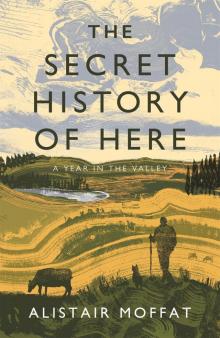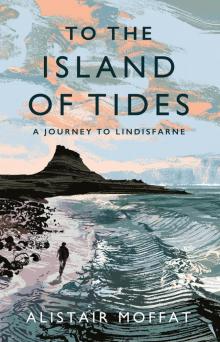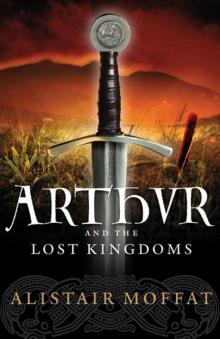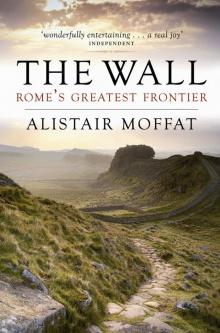- Home
- Alistair Moffat
Britain’s Last Frontier Page 6
Britain’s Last Frontier Read online
Page 6
These things happened. Excavations over a long period at what is known as The Sculptor’s Cave at Covesea, near Lossiemouth on the coast of the Moray Firth, have uncovered evidence of remarkable prehistoric rituals. Only accessible at low tide and, according to one archaeologist, ‘never touched by the sun’, the cave opens through two entrance passages at the foot of a sheer sandstone cliff. In prehistoric times, it may have been surrounded by the sea – perhaps it became the Isle of the Dead – and even more difficult to reach.
It was a liminal place and in many senses. In the absence of texts and with little more than the stones and bones of archaeology as an uncertain guide, the beliefs of the early peoples of Scotland can only be surmised. But it seems that caves were places of great spirituality, portals to another world. Three thousand years ago, when the children at Covesea were decapitated, the cosmos had at least three clear spheres – this was the familiar system of an underworld, the Earth and the heavens above. Many Christians still visualise the dark and fiery pits of Hell below us, the temporal and temporary world we live in and a paradise floating somewhere overhead.
These labels and the characteristics attached to them are, of course, recent and are unlikely to have been shared by the people who made the difficult journey to the Covesea cave. If they committed the souls of their dead children in that place by choice, it is unlikely that it will have had hellish connotations. More probable is the sense of Earth gods and goddesses, deities or spiritual forces that might somehow receive their young ones, dead before their time. And perhaps it was significant that the sun never shone into the entrances of the cave.
What certainly mattered in the ancient belief system of the people of Covesea was something atmospheric, even mysterious. In the shadowy depths of the cave, there is a pool of water. Still and shimmering, it was sacred, perhaps the focus of the shrine. Valuable bronze and iron objects were found in or near it – and that was by no means unusual. All over Britain and much of Europe, prehistoric peoples cast metal objects, their most precious portable possessions, into pools, lochs, rivers and other watery places. Clearly they believed the gods to reside below the dark lustre of the water. At Covesea and elsewhere, it was not a pool but a bridge to another world.
In 1929 and 1930, Sylvia Benton and a team of local workmen found more than 1,800 human bones. It appeared that the cave had been used as an ossuary and, as in communal chambered tombs in Orkney and elsewhere, the skeletons had been disarticulated. Metal objects uncovered amongst the debris dated the earliest use of what seemed to be a shrine to some time around 1,000 BC. Many bones belonged to children and a close examination of the cervical vertebrae showed that they had been decapitated, almost certainly when they were already dead.
After two centuries or so, it seems that beliefs shifted elsewhere and the bones in the cave lay undisturbed for many years. Working through the strata, Sylvia Benton’s team came across clear evidence of a later revival, a time when people began to come back to Covesea with their dead. Roman coins, pins, beads and bracelets were discovered and the excavators were able to date the second period to the 2nd, 3rd and 4th centuries AD.
When archaeologists again took an interest in this fascinating site in the late 1970s, new techniques allowed a great deal more precision. Near the entrances to the cave shrine, Ian and Alexandra Shepherd made an arresting find. They came across the lower jawbones of several children. It appeared that once they had been decapitated, their severed heads had been displayed on poles. And, as the flesh and hair fell away in the winds and rain that blew in off the Moray Firth and the little skulls were exposed, the lower jaws became detached and dropped to the ground. But, strangely, no skulls were found.
When the Shepherds looked more closely at the cervical vertebrae under powerful microscopes, they could see that one had been cut clean through by a single chopping stroke. Smiths working in bronze around 1,000 BC could not have produced a blade hard and sharp enough to cut through bone in that way. Other vertebrae showed signs of marks made by equally sharp and heavy blades. Were there two distinct periods in the life of the cave shrine when severed heads were set up for veneration of some kind? Radiocarbon dating was conclusive. One of the vertebrae was cut some time between 231 AD and 395 AD. This incontrovertibly placed the second occupation of Covesea in what is often called the Iron Age, a time when heavy and fearsomely sharp weapons were forged.
What also intrigued the Shepherds was a clear change in emphasis. The later severed heads, from the 3rd and 4th centuries AD, were almost all adults and only one of the cervical vertebrae came from the skeleton of a child. Once more, beliefs were shifting.
There was, however, one constant, something shared by the prehistoric peoples of the Moray Firth with many Celtic societies across Western Europe. In his history of the Roman conquest of what became France, De Bello Gallico, Julius Caesar was struck by the importance of the human head in the beliefs of his enemies. Because they believed absolutely in an afterlife, the warriors he faced could be recklessly brave and very difficult to subdue. Moreover, some even fought naked in battle, certain of the protection of their gods. Not only did they believe their soul to be indestructible in death, they also thought that it resided in their heads. And if you cut off the head of an adversary, you could capture his soul. Plutarch described the actions of a Celtic nation known as the Senones when they defeated a Roman legion at Clusium in Northern Italy:
They cut off the heads of enemies slain in battle and attach them to the necks of their horses. The bloodstained spoils they hand over to their attendants and carry off as booty, while striking up a paean and singing a song of victory; and they nail up these first fruits on their houses . . . They embalm in cedar oil the heads of the most distinguished enemies, and preserve them carefully in a chest and display them with pride to strangers, saying that for this head one of their ancestors, or his father, or the man himself, refused the offer of a large sum of money. They say that some of them boast that they refused the weight of the head in gold.
Across France and elsewhere, sacred sites have been excavated where heads were displayed in niches or in some other way. Dating mainly to the late first millennium BC, hundreds of heads carved in wood and stone have been found.
When Rome marched into the north of Britain after AD 70 and the legions moved against the Brigantes, a federation of kindreds straddling the Pennines, a pitched battle was fought at Stanwick, the site of a fort near Scotch Corner in Yorkshire. Amongst the debris at the foot of the ramparts, archaeologists were surprised to find skulls without associated skeletons and that they appeared to be older than the date of the battle. They had come across the remains of what became known as a ghost fence. When the legions attacked the Brigantian stronghold, their priests had set up a ring of skulls, certain that their immense power would turn back the Roman attack. But the gods and the souls of the dead failed them and Stanwick was overrun.
Off with their Heads
With more than 400 deities noted in one source or another, Celtic religious beliefs are far from clear or consistent but one theme recurs. It revolved around the importance of the head, apparently the locus of the soul for many Celts in Europe and in Britain and Ireland. As Julius Caesar noted in De Bello Gallico, severed heads were displayed in sacred places and much sought after as trophies. In Scotland, at Lochend near Edinburgh, a multiple burial dating to the 1st or 2nd centuries AD has been found. The skeletons of at least twenty adults and one child were recovered. But seven skulls were missing, and the neck vertebrae showed that they had been removed by a deep sword cut to the neck at the time of death. Archaeologists made another telltale discovery. In the loose earth near the burial, they found six skulls. It appears that they had been placed there for display. Was another ghost fence built at Lochend? Much closer to Covesea, Sueno’s Stone in Moray was carved in the 9th century AD. It carries a very graphic representation of a battle. One of the sequences on this famous Pictish stone is particularly gory – a row of headless bodies, presu
mably the defeated whose heads had become trophies.
It may well be that, at Covesea, similar beliefs were at work. When the priests decapitated the children and the older corpses, they may have set up their skulls on poles at the entrances to the cave as a ghost fence, a means of deterring any who might defile the sanctity of the shrine within. The souls of the dead may have been the guardians of an Otherworld, the realm of the ancestors, and perhaps the skulls of children were thought to possess a special, pristine power.
Twenty-first-century scientists have recently been able to add something more forensic to these fascinating mysteries and specifically to say more about the origins of the ancestors of the early peoples of Moray. As the decapitations in the cave show so vividly, these people did not think like us – but they did look like modern human beings. Apart from clothes, haircuts and other obvious accoutrements of 21st-century life, the major difference in the early population was demographic. Compared to modern society, they were young. Often because of complications in childbirth (in an era before contraception), women died earlier and, if they survived the years of fertility, they aged faster in a society without dentistry or antibiotics. For men, their life expectancy depended very much on what they did. As now, aristocrats and royalty lived longer than ordinary people. The one major difference was an assumption that men of noble birth would be warriors and such records as exist for early Scotland are littered with the bloody corpses of noblemen who fell in battle.
The people who entered the cave at Covesea were like us in another, very important way. Many modern Scots share their DNA. At the height of the last Ice Age, small communities out-wintered the snows and storms in steep-sided valleys in south-west France and northern Spain. Known as the Ice Age refuges, these places sheltered a remarkable people. On the walls of dark, secret and sometimes precipitous caves they painted their world. At Lascaux, Chauvet, Altamira and in hundreds of other hidden places, herds of wild horses, deer, wild cattle and other animals thunder across the cave walls. Sometimes the paintings bear an eerie signature. After filling their mouths with pigment, artists placed a hand flat on the cave wall, sprayed over it and left a stencil.
The DNA marker (a variant specific to south-west France and northern Spain) of the male cave painters was M284. And, when the weather warmed and the ice began to retreat, men carrying this marker moved northwards. In a matter of only a few generations, many reached the furthest end of Europe, what would become Scotland. M284 became a founding lineage and now 4 per cent of all men living in Scotland, about 100,000, are their direct descendants. In the millennia immediately after the Ice Age this proportion will have been much higher and many of the people of Covesea will have been the direct descendants of the cave painters. But to infer any accompanying cultural transmission or a continuity of belief would be stretching the evidence to breaking point.
Until approximately 4,000 BC, there were large islands in the North Sea and, before then, much of the southern basin had been dry land, a lost subcontinent now known to scientists as Doggerland. Its 5,000-year history was an effect of the last Ice Age. Over Scandinavia, a huge ice dome pressed down on the crust of the Earth and, in turn, pushed up the land to the south in what is known by geologists as a forebulge. This extraordinary phenomenon, a lost world to the east of Britain, was very significant for our early history for it meant that the pioneers who populated Scotland after the ice could walk there.
While the cave painters came from the south, other founding lineages approached from the east, having crossed Doggerland, and yet more came from the west, approaching Scotland up the Irish Sea corridor. In Moray, the legacy of these ancient population movements is very striking. More than 27 per cent of all men in the coastlands (and down as far south as Stonehaven the proportion is 30 per cent) carry S21, a DNA marker that originated in northern Europe. By contrast, only 7 per cent of men in the Hebrides have it. There the pattern is reversed and most men carry S145, a marker that took a western route to Scotland and is rare in the east. The statistics do not exactly match the geography but the general pattern is clear. Allowing for a degree of modern population movement, the Y chromosome DNA of the eastern Lowlands of Scotland is different from that of the Highlands and the west. In a meaningful way, the Highland Line was, from early times, a frontier between peoples whose ancient origins differed significantly.
In England, Y chromosome DNA sampling has exposed a similar east–west divide despite a lack of dramatic geography. There is a simple but not immediately obvious reason for this. As a land-based culture used to travelling in vehicles of various sorts, we easily forget the historical role of seas, lochs and navigable rivers as highways. For all but the last 150 years, travel on water was faster and more reliable than any overland route. Ancient colonisation hugged the coastline as communities expanded or moved on into virgin or sparsely populated territory by boat, often in short-range hops. Britain’s eastern and western coastlines are very much longer than its southern or northern and, once settlers had turned one way or the other, either into the Irish Sea or, after 4,000 BC, the North Sea, they moved north, using the sea as a highway. Early seaborne trading contacts further encouraged this east–west population split. Travel overland was only undertaken when absolutely necessary or where navigable rivers and lochs (such as in the Great Glen) made journeys manageable.
The greatest revolution in world history is also the most mysterious. Farming changed lives utterly but the processes and people who drove this revolution remain unknown. Only DNA research offers a sense of how ideas moved from one community to another and across continents. The domestication of animals and the cultivation of crops began in what used to be called the Fertile Crescent or Mesopotamia. Now Iraq and parts of Syria, it had a benign climate and was watered by two great rivers, the Tigris and Euphrates. Some time around 9,000 BC, the new techniques of food production began to spread and it appears that women were in the vanguard of this slowly evolving revolution.
Until the beginnings of mechanisation in the early 20th century, most of the routine drudgery of farm labour – jobs like weeding, mucking, milking, singling, shawing and sickle work – was done by women. In Scotland, they were latterly known as bondagers after the nature of their contracts with farmers. Over an enormous span of time, 11,000 years, it seems that little changed. Moving in step with the archaeology of the spread of farming across Europe, two mitochondrial DNA markers (the sort of DNA passed on by mothers to their daughters) can be detected approaching Scotland from both the east and the south-west. Around 4,000 BC, a new marker, mtDNAJ1b1, arrived in western Britain and Ireland. Approximately 3 per cent of Scottish women, or 75,000, still have it in their genes. Simultaneously, a second new marker made landfall in the east. This was mtDNAJ2a1 and it had made a long journey up the great river valleys of Europe, the Danube and the Rhine.
These women were not alone. Over a lengthy period after 4,000 BC, a new Y chromosome marker arrived and began to replicate very quickly indeed. Now R1b is carried by between 60 per cent and 70 per cent of all Scottish men, around 1.75 million. The reason for this explosion in the proportion of a particular marker must be associated with the success of farming. More food was produced, it fed more people and more people were needed to bring in bigger harvests and increase the size of herds and flocks. It appears that farming ignited a population explosion in prehistoric Scotland.
Language often follows population movement and new techniques demanded new vocabulary. It seems very likely that the spread of farming from Mesopotamia – east as well as west – also spread the large family of languages known as the Indo-European group. Although it may seem like a puzzling claim to many British people, most European languages have a great deal in common, both in structure and vocabulary. Certainly French speakers are much more likely to understand Spaniards or Italians than, say, Japanese or Koreans.
Against that linguistic background, economics began to exert a powerful influence. Because it can produce surpluses in good years and its sea
sonal cycle allows other work such as basic manufacturing, farming encouraged trade. Archaeologists have turned up an increasing range of ancient commodities. In the second and first millennia BC, northern Europe developed a thirst for Mediterranean wine and the bronze smiths of the south needed British tin to make their lustrous, gold-like alloy. Pelts, textiles, dye, amber, gold and silver all made long journeys, probably passing through several pairs of hands on the way. Historians now believe that these busy commercial contacts, mostly seaborne, also carried a cargo of language. Up and down the Atlantic coastlines of Europe and Britain, merchants needed to understand producers for both of them to profit and it seems that a family of Celtic languages developed into a trading lingua franca.
From inscriptions, place-names, proper names and occasional scraps of transcription and translation, the distribution of these Celtic languages can be reasonably mapped across Western Europe. In what is now Portugal and Spain, Lusitanian and Celtiberian were certainly spoken in the first millennium BC, while in France and Northern Italy, Gaulish and Lepontic were heard. Up and down the length of Britain dialects of Old Welsh (a clear ancestor of the modern language and related to Gaulish) became common and, in Ireland, an early form of Gaelic was spoken. Over time, these languages followed different paths, some to extinction, others developing marked differences. By the time the bodies of the dead children were first brought into the cave at Covesea, around 1,000 BC, it is likely that their parents and their priests spoke a northern dialect of Old Welsh. By the time the cave was reoccupied, the language had acquired a distinctive name and its speakers had become a famous historical enigma.

 The Secret History of Here
The Secret History of Here The Night Before Morning
The Night Before Morning To the Island of Tides
To the Island of Tides Arthur and the Lost Kingdoms
Arthur and the Lost Kingdoms Britain’s Last Frontier
Britain’s Last Frontier The Faded Map: The Lost Kingdoms of Scotland
The Faded Map: The Lost Kingdoms of Scotland The Wall
The Wall